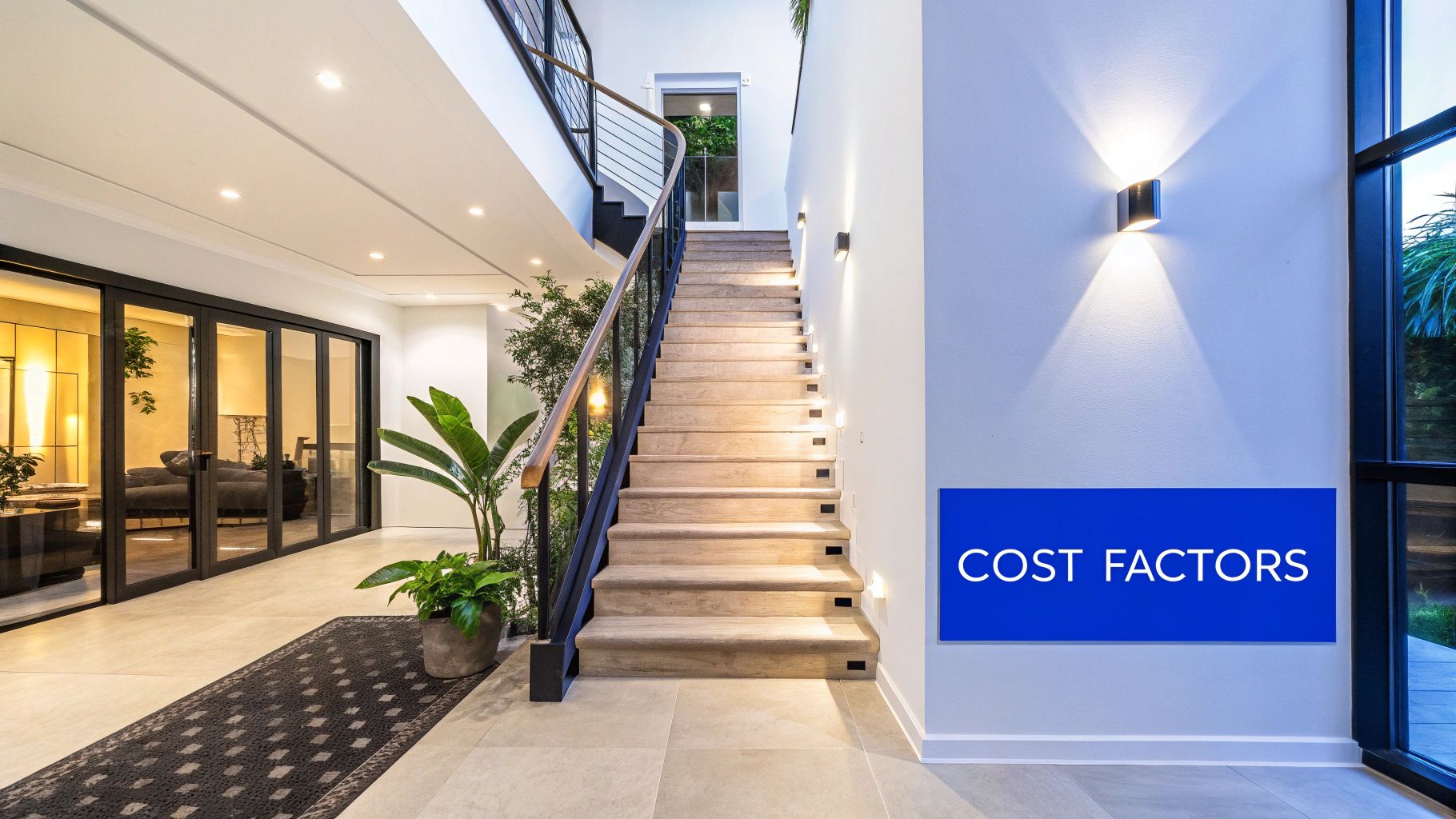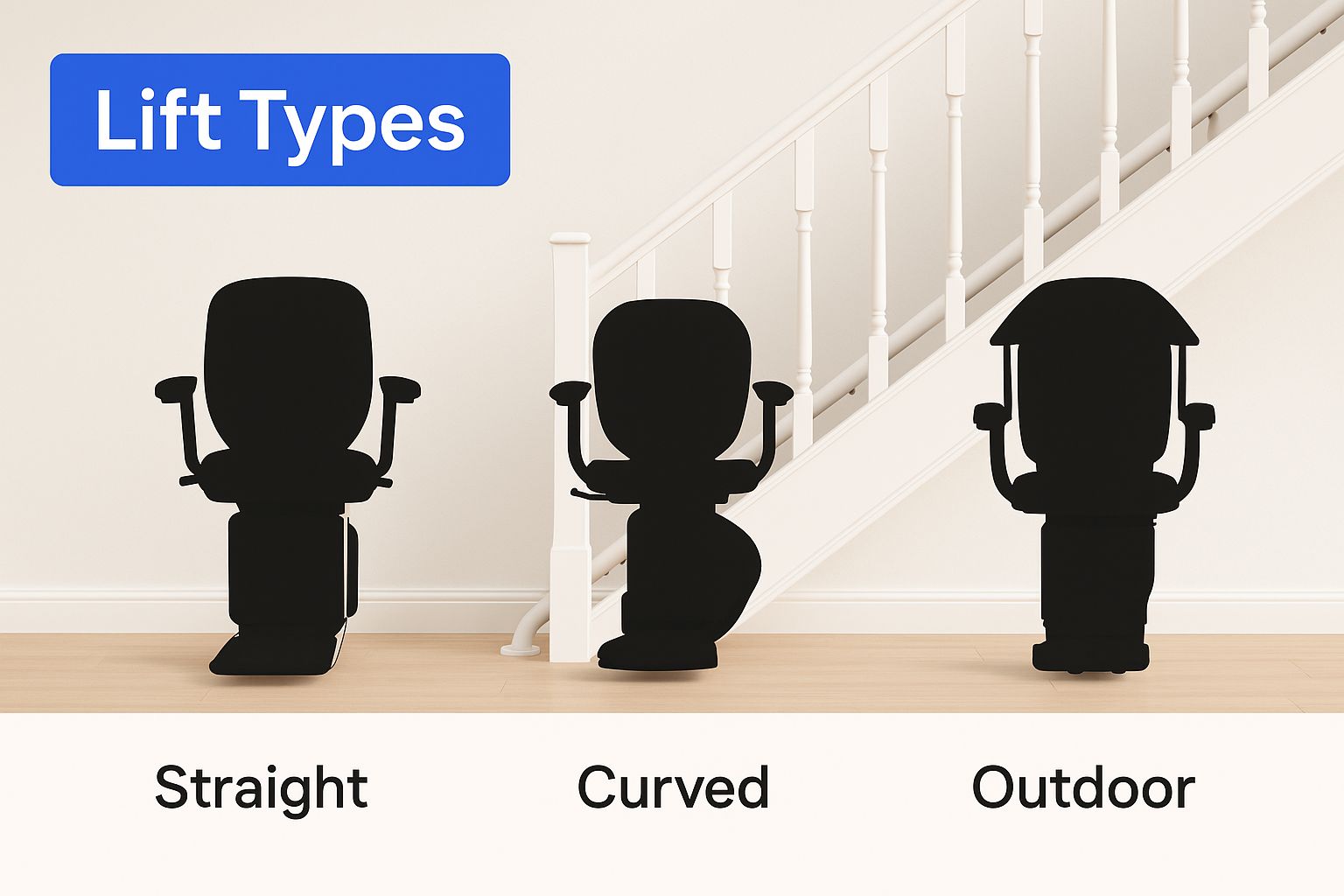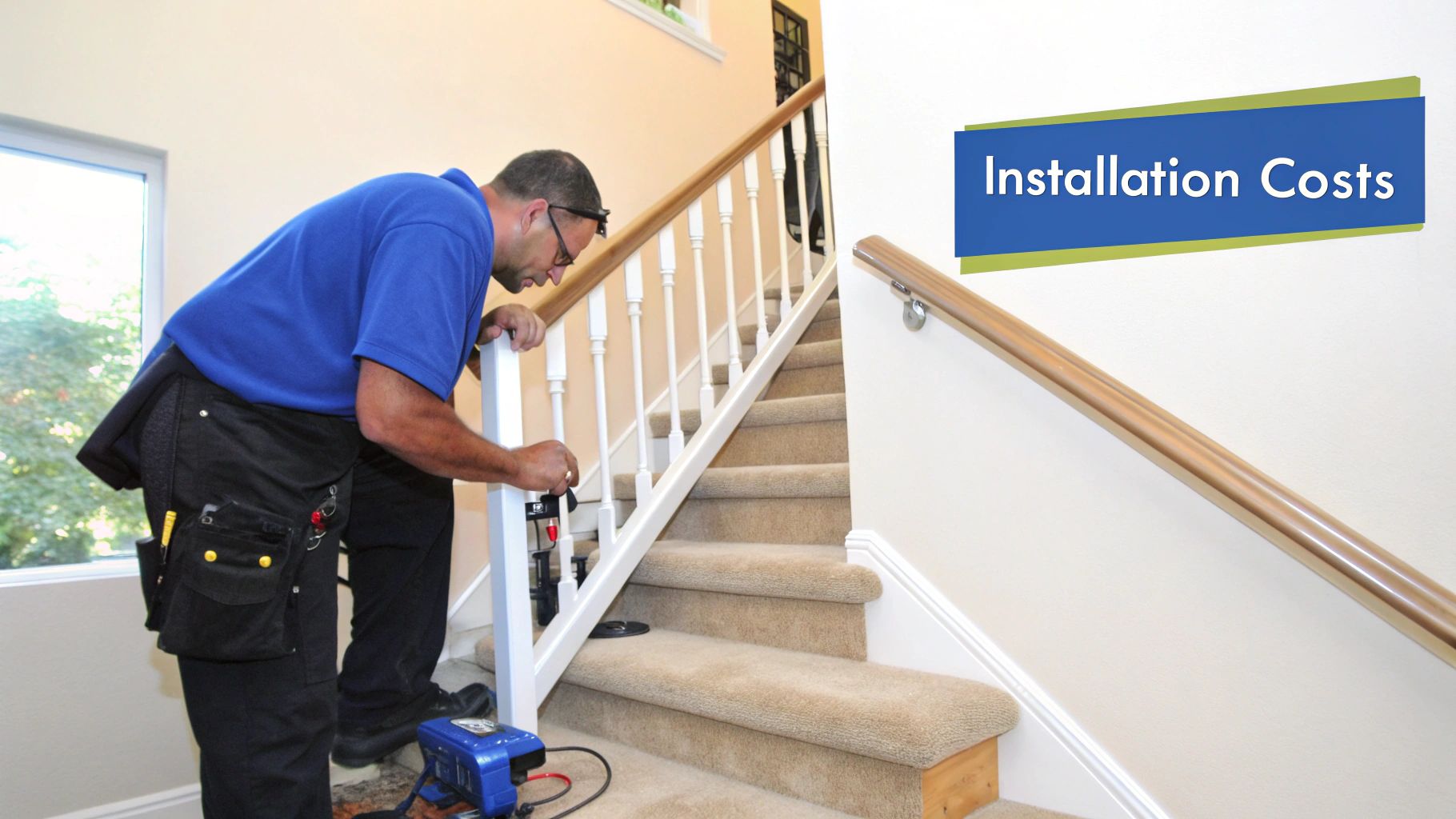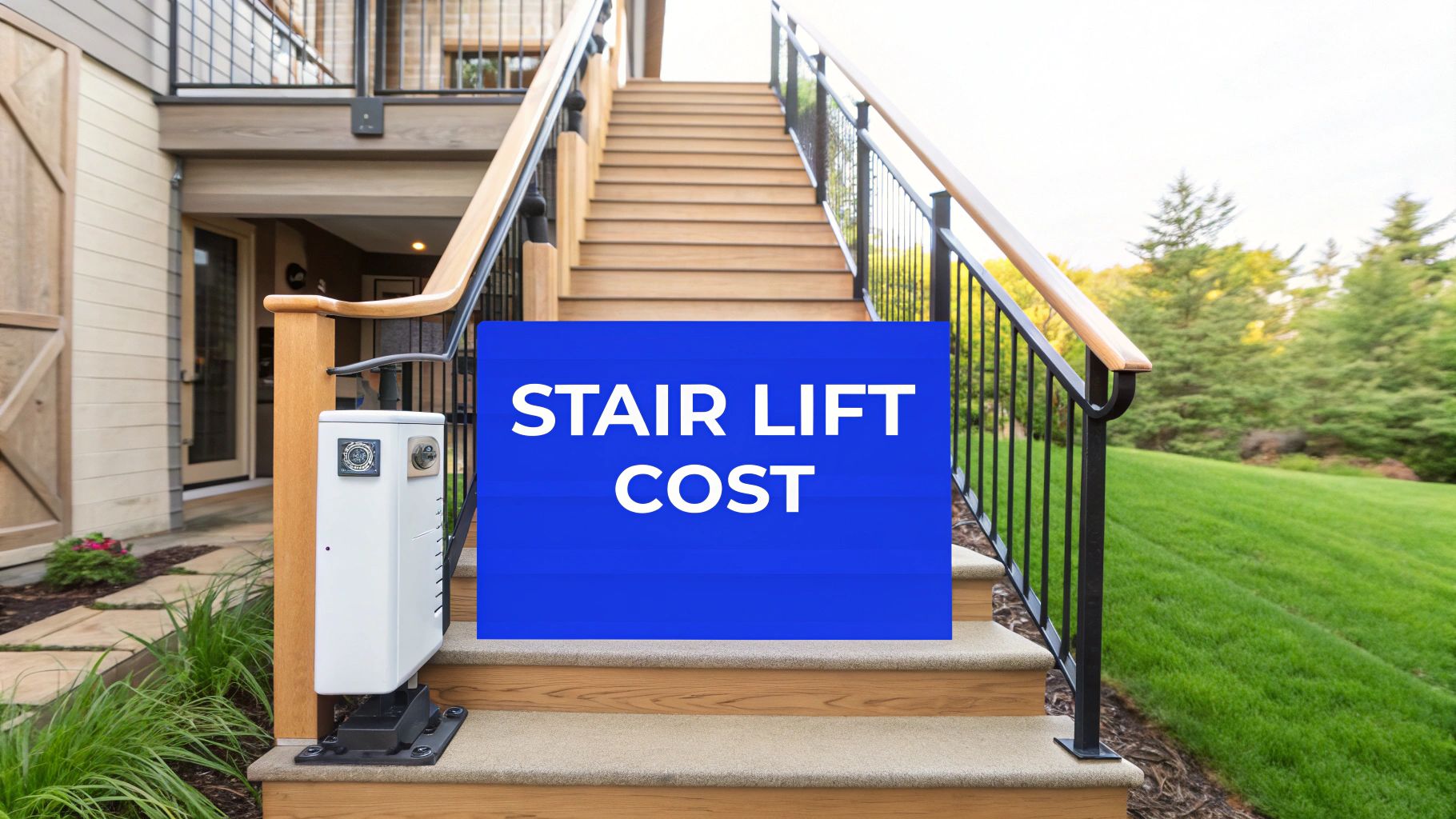So, you're wondering how much a stair lift costs. It's one of the first and most important questions people ask, and the honest answer is: it depends. The price can range anywhere from $2,500 to $15,000, and what you'll ultimately pay comes down to your home's unique layout and the features you need.
It helps to think of it like buying a car. You have your standard, no-frills models that get the job done, and then you have the fully-loaded versions with all the custom upgrades. The final sticker price really reflects those choices.
Decoding Stair Lift Prices
Trying to pin down the cost of a stair lift can feel a bit overwhelming at first, but it really boils down to a few key things. By far, the biggest factor is the shape of your staircase. Is it a simple, straight shot from one floor to the next? Or does it have turns, curves, or a landing in the middle?
That one detail—straight versus curved—is the single most significant element that will shape your final quote.
A straight staircase is the most straightforward and budget-friendly scenario. Since the rail can be a standardized, factory-built piece, the costs for both materials and installation are lower. On the other hand, a curved staircase is a completely different ballgame. It requires a custom-built rail that’s meticulously designed to hug every bend and angle of your specific stairs. That level of custom fabrication naturally involves more materials, engineering, and specialized installation.
A Starting Point for Your Budget
To give you a clearer picture of what to expect, let's look at some typical price ranges. These figures generally cover the cost of the chair and rail system itself, plus professional installation—which is absolutely essential for safety and to keep your warranty valid.
- Straight Stair Lifts: These are the most common and typically cost between $2,500 and $6,000. The price can shift based on the brand, the length of your staircase, and any extra features you choose.
- Curved Stair Lifts: Because they are custom-made from scratch, these models start at a higher price point. You can expect them to begin around $9,000 and often go up to $15,000 or more, depending on how complex the turns are.
- Outdoor Stair Lifts: These lifts are built tough to handle rain, sun, and snow. They have weatherproof components and durable covers, which puts their price tag in the $4,000 to $12,000 range.
It's important to remember these are just baseline figures. Just like with a car, adding features like a powered swivel seat, a retractable rail at the bottom of the stairs, or upgraded upholstery will add to the final cost.
The table below gives you a quick snapshot of what you can generally expect to invest in a new stair lift.
Average Stair Lift Cost at a Glance
This table provides a quick summary of the typical price ranges for different types of new stair lifts, including basic installation.
| Stair Lift Type | Typical Price Range (USD) |
|---|---|
| Straight Stair Lift | $2,500 – $6,000 |
| Curved Stair Lift | $9,000 – $15,000+ |
| Outdoor Stair Lift | $4,000 – $12,000 |
Ultimately, the only way to get a firm, accurate price is to schedule a free in-home assessment with a reputable dealer. A professional can take precise measurements, talk with you about your specific mobility needs, and give you a detailed quote with no obligation. It’s the best way to find a solution that's not only safe and reliable but also a perfect fit for your home and your budget.
The Cost of a Straight Stair Lift

When you start exploring stair lift prices, you’ll quickly find that straight stair lifts are the most common and budget-friendly choice. You can think of them as the “off-the-rack” option in the mobility world. Because their design is standardized, they can be mass-produced, which keeps manufacturing costs down and saves you money in the end.
The real key to their affordability lies in the rail. A straight staircase doesn't need a custom-bent, specially engineered track. Instead, it uses a simple, linear rail that a technician can cut to the perfect length right in your home. This straightforward approach gets rid of the complex design work and long manufacturing waits tied to curved models, making it a much faster and more economical solution.
The demand for these devices is strong and only getting stronger. The global stair lifts market was valued at around USD 2.15 billion in 2023, and it's expected to keep growing as the population ages and technology brings new safety and design features. You can dive deeper into this market growth in this detailed industry report.
What You Get for the Price
A basic straight stair lift package typically runs between $2,500 and $6,000. That price almost always includes professional installation, which is non-negotiable. Trying to install it yourself is not only dangerous but will also void your warranty instantly.
So, what does that price tag actually get you? A standard package includes all the core features you need for safe, reliable use.
- The Chair and Rail System: This is the heart of the lift, including a comfortable seat and the track it glides on.
- Safety Sensors: These are essential. They automatically stop the lift if they detect anything blocking the stairs.
- Seatbelt: A standard lap belt is always included to keep the rider secure.
- Remote Controls: Most models come with two remotes, so you can easily call the lift to you, whether you're at the top or bottom of the stairs.
- Battery Power: Modern lifts run on rechargeable batteries. This is a fantastic feature because it means your lift will still work even if the power goes out. The unit charges itself automatically when it's parked.
Upgrades and Add-Ons That Affect Cost
While a base model is more than enough for many people, you can always add features for extra comfort, safety, or convenience. Just remember, each upgrade will nudge the final price up.
Key Takeaway: The base price covers everything you need for safe, day-to-day operation. Optional upgrades are all about tailoring the lift to your specific needs, your home's layout, and your personal preferences.
Here are a few of the most common additions to consider:
- Powered Swivel Seat: This feature is a game-changer. It automatically turns the seat at the top of the stairs, so you can get off safely and easily, away from the edge of the staircase. It's an incredibly valuable upgrade for anyone with significant mobility challenges.
- Powered Folding Rail: If the end of the rail would block a doorway or a busy walkway, a powered folding rail is a must. It automatically lifts the end of the track up and out of the way when the lift isn't being used, keeping your pathways clear.
- Upgraded Upholstery: The standard vinyl seat is built for durability and easy cleaning, but you can often choose from premium fabrics or even leathers. This lets you match the chair to your home's decor for a more seamless look.
- Heavy-Duty Models: For users who need a higher weight capacity, heavy-duty lifts provide a stronger frame and a more powerful motor. These models do come at a higher price but ensure safe operation for everyone.
It’s one of the first questions people ask: why is there such a huge price difference between a straight and a curved stair lift? Seeing a quote jump from around $3,000 for a straight model to $9,000 or more for a curved one can be a shock. The answer has nothing to do with the chair itself—it’s all about the rail.
I like to use a simple analogy: a straight stair lift is like buying a high-quality suit off the rack. It’s a standard, well-made product that can be easily adjusted to fit. A curved stair lift, on the other hand, is like getting a fully bespoke, custom-tailored suit. Every single measurement is taken, and every piece is cut and stitched just for you.
The Custom Manufacturing Process
You can't just pull a curved stair lift rail off a shelf. It has to be manufactured from scratch to perfectly follow every turn, bend, and landing of your specific staircase. This isn't a simple process; it’s a detailed, multi-step journey that directly shapes the final cost.
It all starts with a meticulous survey of your home. A trained technician comes to your house to take incredibly precise measurements. Many modern suppliers use advanced photo-measuring technology, capturing hundreds of images from every conceivable angle. This data is then loaded into specialized software, which builds a perfect 3D model of your staircase, accounting for every subtle curve and incline with millimeter accuracy.
This digital blueprint is then sent to the factory. There, engineers design and fabricate a rail that is truly one-of-a-kind. It’s built in sections for easier on-site assembly, but each piece is bent and welded to those exact specifications from the 3D model.
Key Insight: You're not just buying a product; you're commissioning a piece of custom engineering designed exclusively for your home. This bespoke process involves significantly more labor, materials, and specialized technology than a standard straight rail.
How Staircase Complexity Drives Up the Price
The baseline cost for a curved stair lift usually starts around $9,000, but that number can climb depending on a few key factors. The main cost drivers are the complexity of your staircase and the total length of the rail needed.
Here are the elements that can add to the price tag:
- Number of Bends: A single 90-degree turn is much simpler to fabricate than a tight 180-degree "switchback" turn you might see on a landing. Each bend adds to the manufacturing complexity and material costs.
- Irregular Angles: Not all stairways have perfect 90- or 180-degree turns. Any non-standard angles or unique curves require even more sophisticated engineering to make sure the ride remains smooth and stable.
- Total Length: It's a simple fact—longer staircases need more rail material, which naturally increases the overall price.
- Intermediate Landings: If your staircase has a flat landing partway up that the lift needs to travel across, this adds another layer of customization and cost to the rail's design.
To get a clearer picture of these differences, let's break them down side-by-side.
Cost Comparison: Straight vs. Curved Stair Lifts
| Factor | Straight Stair Lift | Curved Stair Lift |
|---|---|---|
| Rail Design | Mass-produced, standard track | Custom-built for one specific staircase |
| Manufacturing | In-stock, ready for quick installation | Bespoke; requires a home survey and factory fabrication |
| Installation | Simpler, faster installation process | More complex assembly of custom-fit sections |
| Labor & Tech | Standard labor and tools | Specialized design software and precision engineering |
| Reusability | Can be removed and reinstalled elsewhere | Rail is unique to the home; cannot be reused |
The table really highlights why the investment is so different. With a curved lift, you're paying for a tailored solution from start to finish.
This visual helps illustrate the fundamental difference between the main types of lifts available.

As you can see, the very silhouette of a curved lift suggests its more intricate and personalized nature compared to a standard straight model. This visual difference is a direct result of the complex manufacturing process and, ultimately, the final cost. Because they are such custom projects, you'll find that renting a curved stair lift is rarely an option—the rail is made for one home and one home only.
At NJ Caregiving, we can help you navigate these options to find a safe, practical, and sustainable solution for your home in Princeton or anywhere in Mercer County.
Outdoor and Refurbished Stair Lift Pricing

While straight and curved models solve most indoor challenges, your options don't stop at the front door. Two other key categories—outdoor and refurbished lifts—can make a huge difference in your final decision and cost.
Outdoor lifts are built tough, giving you safe, reliable access to your porch, deck, or garden steps. Think of them as the all-weather, heavy-duty version of an indoor lift. That extra ruggedness does come with a higher price tag, typically ranging from $4,000 to $12,000.
What Makes Outdoor Lifts More Expensive?
That higher cost isn’t just for show; it directly reflects the specialized engineering and materials needed to handle whatever the weather throws at it. You can't just put an indoor model outside and hope for the best—these are purpose-built machines designed to last.
Several key upgrades contribute to the cost:
- Weatherproof Components: All the sensitive electronics and the motor are completely sealed to keep out rain, snow, humidity, and extreme temperatures.
- Durable Materials: The rail is usually made from anodized aluminum or given a special weather-resistant coating to stop rust and corrosion in its tracks.
- Marine-Grade Vinyl: The seat upholstery is the same tough, UV-resistant material you’d find on a boat, preventing it from cracking, fading, or getting mildew.
- Protective Cover: Every outdoor lift comes with a heavy-duty waterproof cover to shield the chair and power unit when it’s not being used.
These enhancements are what allow the lift to operate safely year-round. It’s no surprise that the demand for these solutions is growing. The global stair lift market is on track to hit USD 1.43 billion by 2030, a boom driven by an aging population that wants to maintain full access to their homes. You can dig into the numbers yourself in this detailed market report.
The Smart Way to Save: Refurbished Stair Lifts
If the price of a brand-new lift feels like a stretch, a refurbished or reconditioned model can be a fantastic, budget-friendly choice. These are pre-owned lifts that have been professionally brought back to like-new condition, often saving you $1,000 or more compared to buying new.
But here’s the crucial part: where you buy it from matters immensely.
Buying a used stair lift from a private seller on an online marketplace or in the classifieds is incredibly risky. You have no idea of its true history, it won't have a warranty, and finding a qualified technician willing to install a third-party unit is a nightmare.
Going through a reputable dealer, on the other hand, gives you savings without sacrificing safety. A professionally refurbished lift should always include:
- A Solid Warranty: Look for a minimum of a one-year warranty covering all parts and labor.
- New Batteries: The batteries must be brand-new. This ensures the lift works reliably, especially if the power goes out.
- Rigorous Safety Checks: The dealer should have thoroughly inspected, tested, and cleaned the unit, replacing any parts that show wear.
- Professional Installation: The dealer handles the installation, guaranteeing it meets all safety codes and validating your warranty.
Choosing a refurbished stair lift from a trusted supplier is a smart financial move that doesn’t compromise on reliability. It's a proven path to regaining full use of your home without breaking the bank.
Key Factors That Affect Your Final Price
The type of stair lift you need—straight, curved, or outdoor—is what sets the starting point for your budget. But from there, the final number on your quote is really shaped by a handful of specific choices and upgrades unique to your home. Think of the base model as a blank canvas; the features you add are the brushstrokes that complete the picture and determine the final cost.
Getting a handle on these individual cost drivers is key. It helps you read any quote with confidence, ask smart questions, and figure out which features are essential for safety versus which ones are just nice to have. This knowledge lets you put together a solution that fits your life and your budget.
This ability to customize is a big reason why the demand for mobility solutions is growing. In fact, the market for stair lifts and climbing devices is expected to grow significantly, surpassing USD 8.19 billion by 2035. This boom is driven by a real need for aging-in-place solutions and better technology, making stair lifts more accessible than ever. You can read more about what's ahead for mobility aids in this market forecast from Future Market Insights.
Core Features and Upgrades
Going from a basic model to a fully featured lift involves a few important decisions. Each of these upgrades adds to your total investment, so it’s good to know what they are and why you might want them.
-
Power Source (AC vs. Battery): Almost all modern indoor stair lifts run on DC battery power, and for good reason. They charge continuously at their docking stations, which means they'll keep working even if the power goes out. Older, less common AC-powered models plug right into the wall and will stop working during an outage, making them a much less reliable choice.
-
Seat and Footrest Options: A manual swivel seat and a folding footrest come standard with most base models. However, upgrading to powered versions can be a huge help for convenience and safety, especially for anyone with limited strength or flexibility.
-
Upholstery Choices: The standard seat is usually made of a durable, easy-to-clean vinyl. For a bit extra, you can often upgrade to premium fabrics or even leather to better match your home’s decor and add a personal touch.
Essential Upgrades for Specific Homes
Some features aren't just about comfort—they're necessary solutions for tricky layouts. These are often the most important single add-ons you’ll see on a quote.
The most common and impactful upgrade is the powered folding rail. This isn't a luxury item; for many homes, it's a non-negotiable safety requirement that ensures hallways and doorways remain clear and unobstructed.
You’ll need a powered folding or retractable rail if the bottom of your staircase is right next to a doorway or in a busy hallway. When the lift isn't in use, this feature automatically lifts the end of the rail out of the way, preventing a serious trip hazard for everyone in the house. Expect this crucial safety feature to add between $500 and $1,200 to your final price.
Comparing Key Cost Drivers
To make sense of how these options add up, it helps to see them side-by-side. The table below breaks down some of the most common add-ons and their typical impact on your total cost.
| Feature or Upgrade | Standard Inclusion | Optional Upgrade Cost (Approx.) | Why You Might Need It |
|---|---|---|---|
| Swivel Seat | Manual Swivel | $500 – $1,000 for Powered Swivel | For safer transfers at the top of the stairs, especially for users with limited mobility. |
| Folding Rail | Fixed Rail | $500 – $1,200 for Powered Folding Rail | To prevent an obstruction in a hallway or near a doorway at the bottom of the stairs. |
| Weight Capacity | 250-300 lbs | $500 – $1,500 for Heavy-Duty Model | For users who need a higher weight capacity (often up to 400-500 lbs). |
| Upholstery | Standard Vinyl | $200 – $500 for Premium Fabric/Leather | To match the chair's look with your home's interior design and decor. |
When you understand this checklist of potential costs, you can talk to dealers from a position of knowledge. It ensures you get a fair price for a system that truly meets your needs.
How to Fund Your Stair Lift Purchase
Figuring out the final cost of a stair lift is the first hurdle. The next, and often bigger, question is: how are you going to pay for it? Thankfully, you're not on your own. There are several financial avenues that can make this essential home modification much more affordable.
The key is knowing where to look and understanding what different programs typically cover.
One of the first questions people ask is whether their health insurance will foot the bill. In most cases, the answer is unfortunately no. Private insurance and Medicare usually classify stair lifts as a "home modification," not as "durable medical equipment" (DME). While they'll gladly cover items like a walker or hospital bed, they see a stair lift as a structural change to your house, which falls outside of standard coverage.
Important Note: Don't just assume you have no options. While direct coverage is rare, some Medicare Advantage (Part C) plans are starting to offer supplemental benefits for home safety devices. It's always worth a phone call to your specific plan administrator to confirm your benefits. You never know what you might be entitled to.
Exploring Government and Non-Profit Assistance
Beyond your personal insurance, there are dedicated programs out there designed specifically to help seniors and people with disabilities fund exactly this kind of equipment. These programs exist to bridge the financial gap and help people continue living safely in their own homes.
- Veterans Affairs (VA) Benefits: If you're a veteran, the VA offers some incredible assistance. Grants like the Home Improvements and Structural Alterations (HISA) grant can provide significant funds for medically necessary home improvements, and stair lifts often qualify.
- State-Level Programs: Many states run "Medicaid Waiver" programs. The whole point of these is to help cover the costs of home modifications to prevent folks from needing to move into a more expensive nursing facility. Check with your state's Department of Health or Aging to see what's available where you live.
- Non-Profit Grants: Don't forget to look at non-profits. National organizations like the Administration for Community Living or local chapters of disease-specific groups (like the ALS Association) sometimes have grants available for assistive technology.
Alternative Funding and Financing Options
What if grants or government aid don't cover the whole expense? You still have practical ways to manage the stair lift cost. Many people turn to the financing plans offered directly by reputable dealers, which can make a big purchase feel much more manageable.
Think of it like financing a new appliance or a car. These plans let you break down the total price into predictable monthly payments over a set period of time. This is a fantastic way to get the immediate safety and freedom of a stair lift without needing all the cash upfront.
Some dealers even offer promotional periods with 0% interest, which is an even better deal. When you're getting quotes from suppliers, make it a point to ask about their financing plans.
Your Top Questions About Stair Lift Costs, Answered
Making a major investment in your home naturally comes with a lot of questions. It's a big decision, and you deserve to feel completely confident. To help you get there, we've put together answers for some of the most common things people ask us about stair lift costs and ownership.
Does Insurance or Medicare Cover Stair Lift Cost?
This is easily one of the most frequent questions we hear, and the straightforward answer is that traditional Medicare (Parts A and B) and most private insurance plans don't cover the cost. They usually see a stair lift as a "home modification," not as "durable medical equipment" (DME) like a walker or a hospital bed.
But that isn't always the end of the road. Some Medicare Advantage (Part C) plans are starting to include supplemental benefits that might help pay for home safety devices. The best thing to do is call your plan administrator directly to see exactly what your specific policy covers.
Can I Save Money by Installing a Stair Lift Myself?
We understand the temptation to save a few bucks on installation by doing it yourself. However, this is one of those projects you absolutely want to leave to the professionals. Trying to install a stair lift on your own is not only incredibly dangerous but will also instantly void the manufacturer's warranty.
A professional installation isn't just a service—it's a critical safety measure. Technicians are factory-trained to make sure your lift is installed according to strict safety codes, guaranteeing it will work safely and reliably for years to come.
How Much Does Stair Lift Maintenance Cost?
Just like a car or any other important piece of machinery, a stair lift needs a little tune-up now and then to keep it in peak condition. Most dealers recommend an annual service check-up, which usually runs between $200 and $400.
During this visit, a technician will look over all the safety features, clean the track, lubricate the moving parts, and check on the battery's health. Many dealers also offer service plans that can make these annual check-ups more affordable.
Is Renting a Stair Lift Cheaper Than Buying?
Renting can definitely be a smart financial move, but only for very specific, short-term needs. If you only need a stair lift for less than six months—maybe for recovery after surgery or while a relative with mobility challenges is visiting—renting is often the way to go.
For any long-term situation, buying almost always makes more financial sense. Rental costs for a straight lift typically involve an installation fee plus a monthly charge of around $250 to $500. As you can imagine, that adds up fast. Curved stair lifts are almost never available to rent because their rails are custom-made for each unique staircase.
Figuring all of this out can feel like a lot, but you don't have to do it by yourself. The team at NJ Caregiving is here to help you find the safest, most practical solutions for maintaining independence at home. Contact us today to learn how we can support your family’s needs in Princeton, Mercer County, and beyond.



